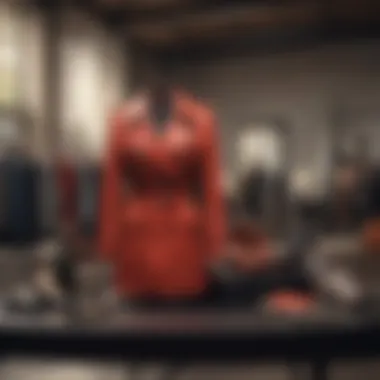The Evolution of Apps for Selling Designer Clothes


Intro
In the digital age, the marketplace for designer clothes has transformed significantly, driven by technology and shifting consumer preferences. The evolution of mobile applications tailored for buying and selling luxury fashion items marks a pivotal moment in how we engage with fashion. This transformation is not only about commerce; it speaks to broader themes such as sustainability, exclusivity, and method of consumption.
As consumers, we now have a diverse range of options that blend ease with ethical considerations. With just a few taps on a smartphone, one can access a plethora of designer shoes, handbags, and attire, often at a fraction of the retail price. This article explores the ascent of resale apps, their features, and their implications for the fashion landscape, emphasizing both their role in sustainable practices and the evolution of shopping habits.
Key Trends
Overview of Current Fashion Trends
The fashion industry constantly evolves, with trends frequently shifting. Currently, the trend towards sustainability influences many consumers' choices. Buyer interest is on second-hand clothes, promoting a shift from fast fashion to more thoughtful purchasing. Apps like Poshmark and Depop cater to this desire by providing platforms where consumers can find pre-loved items from high-end brands.
Additionally, exclusivity holds great appeal. Access to rare pieces or items not widely available allows fashion enthusiasts to express individuality in ways that mass-produced clothing cannot.
Popular Designer Resale Apps
The marketplace is populated with various applications that offer unique features:
- Poshmark: Focuses on community selling, allowing users to share listings and engage with other sellers and buyers.
- Depop: Attracts younger consumers with its social media-like interface, offering a blend of shopping and social interaction.
- The RealReal: Emphasizes luxury authentication, providing assurance that products are genuine, which is essential in the designer market.
These applications are not just platforms but also communities that reshape how consumers approach fashion.
Sustainable Practices
Understanding Sustainable Fashion
The intersection of fashion and sustainability is garnering increasing attention. Buyer awareness around the impacts of fashion on the environment has prompted a demand for transparency. Apps providing a marketplace for preloved designer items contribute to this movement by promoting reuse and minimizing textile waste.
Tips for Sustainable Shopping
To engage in sustainable practices when using resale apps, consider the following:
- Research Brands: Understand their sustainability practices and values.
- Prioritize Quality: Invest in pieces that last, avoiding disposable fast fashion.
- Engage with Sellers: Communicate with sellers to understand the history of an item, enhancing its story and value.
In addition, consider the impact of every purchase. Each transaction can either contribute to a sustainable brand or perpetuate a cycle of overconsumption.
The evolution of apps dedicated to selling designer clothes reflects a significant shift in consumer behavior, driven by technology and a desire for more sustainable practices. By understanding these trends and the role of these platforms, consumers are better equipped to navigate their fashion choices thoughtfully and ethically.
Prolusion to Fashion Apps
The rise of fashion apps marks a significant shift in how consumers engage with designer clothing. These applications are critical in shaping the resale market, allowing users to easily buy and sell high-end fashion items with convenience. Understanding the landscape of fashion apps reveals how they cater to the unique needs of modern shoppers, providing features that enhance the overall experience compared to traditional retail methods.
Mobile technology plays a pivotal role in this transformation. By empowering users with instant access to designer collections and resale opportunities, these apps have revolutionized the way fashion enthusiasts build their wardrobes and express their personal style.
Understanding Fashion Resale Market


The fashion resale market has grown exponentially in recent years. It caters to consumers looking for sustainable, affordable, and exclusive fashion options. The increasing awareness of sustainable consumption trends influences buyer preferences. Individuals are more inclined to purchase second-hand designer clothes as they seek to minimize their carbon footprint and embrace a more eco-conscious lifestyle.
The surge of mobile applications has further fueled this growth, allowing users to access a vast array of items from the comfort of their own homes. Platforms like Poshmark and Depop have created vibrant communities around fashion, enabling users to connect and share their style choices while emphasizing the interconnectedness of sustainable practices.
Role of Mobile Technology in Fashion
Mobile technology is at the forefront of innovation in the fashion industry. The convenience of shopping from a smartphone or tablet has changed consumer habits drastically. Users can browse, compare prices, and make purchases at any time and from any location.
These apps often incorporate advanced features such as virtual try-ons and AI-driven recommendations based on user preferences. This facilitates a more personalized shopping experience that traditional retail cannot match.
Furthermore, mobile apps generally provide secure payment options and easy return processes. They improve customer satisfaction and encourage repeat business. The future of fashion retail relies heavily on integrating mobile technology to keep pace with evolving consumer demands.
Key Features of Designer Clothing Apps
The rise of mobile applications dedicated to the resale and purchase of designer clothing has transformed how people interact with fashion. Key features of these apps are crucial not just for user experience, but also for driving sales and maintaining brand loyalty. The importance of creating an app that resonates with the target audience cannot be understated.
User Interface Design
A well-crafted user interface (UI) is essential in establishing a seamless shopping experience. The simplicity of navigation allows users to quickly access various sections of the app, which enhances engagement. Users today expect functionalities that incorporate clean layouts, appealing graphics, and responsive elements. An app that is uncomfortable to use will likely lose potential buyers.
In addition to aesthetics, usability testing plays a significant role in ensuring that features such as search functions and filtering options work effectively. This leads to greater customer satisfaction and repeat usage. Since many users browse apps while multitasking, intuitive design is paramount. Integrating features like swipe functionalities can facilitate a more fluid experience. Having visually appealing images of designer products can further lure in users.
Personalized Shopping Experiences
Personalization adds a layer of intimacy to the shopping journey. By employing algorithms that track user behavior, apps can curate tailored recommendations that resonate with individual preferences. This can significantly enhance the likelihood of a purchase. For example, if a user frequently browses luxury handbags or particular designers, the app can highlight similar options or notify users about new arrivals.
Another effective feature is the ability to save favorite items or create wish lists. This keeps the shopping experience organized and allows users to return without needing to search for their initial items again. It is also beneficial for sellers. When buyers show clear interest in specific products, sellers can adjust their stock or promotions accordingly.
Secure Payment Options
In a digital-first world, security in transactions is a major concern for users. Fashion apps that prioritize secure payment options build trust with their customers, which is essential for business longevity. Offering multiple payment gateways, including credit cards, PayPal, or mobile wallets like Apple Pay, provides users with the choice they desire.
Additionally, integrating fraud detection systems and offering buyer protection guarantees are good practices. Users will be more inclined to purchase if they know their financial information is safeguarded. Transparency in refund policies also enhances user trust, making customers more comfortable with their decisions.
"A focus on key features such as UI design, personalization, and secure payments can distinctly elevate the competitive edge of fashion resale apps."
Popular Apps for Buying Designer Clothes
The emergence of mobile applications tailored for buying designer clothes has significantly reshaped the fashion landscape. These applications offer a unique combination of convenience and accessibility, making luxury fashion more approachable to a broader audience. The importance of exploring these popular apps lies not just in understanding their functionality but also in grasping their role in transforming consumer behaviors and shaping market trends.
Overview of Leading Platforms
Several platforms have established themselves as leaders in the market for designer clothing apps. Valuables, Grailed, and Vestiaire Collective are just a few examples. Each app presents a distinct approach to fashion resale. Valuables prioritizes high-end luxury items, attracting sellers and buyers who seek exclusivity and premium quality. Grailed focuses primarily on menswear, boasting a diverse range of streetwear and high-fashion items. On the other hand, Vestiaire Collective champions sustainability and ethical fashion practices, incentivizing users to buy second-hand designer pieces.
The user bases of these applications differ, catering to specific demographics and fashion preferences. For women, platforms like Depop have gained traction, blending social media elements with fashion retail, which enhances user engagement. The variety offered by these apps illustrates the diversity within the designer second-hand market and appeals to an array of style sensibilities and budgetary considerations.


Comparison of App Features
When comparing the features of leading fashion apps, certain elements stand out. Factors like ease of use, search functionality, and customer support play pivotal roles in enhancing the user experience. Here is a closer look at key features:
- User Interface: An intuitive design is critical. Apps like Poshmark and ThredUp have sleek interfaces that simplify the shopping process.
- Search Filters: Apps often include filters for sizing, brand, and price, which aids users in finding their desired items efficiently.
- Item Authenticity Verification: A key concern in the luxury resale market. Platforms such as The RealReal employ experts to authenticate items, ensuring buyers are confident in their purchases.
- Community Interaction: Some apps, especially like Depop, foster community through social interaction, allowing users to follow each other and curate personal stores.
Each application capitalizes on these features differently, making it essential for users to understand their priorities when selecting an app to shop for designer clothes.
User Ratings and Feedback
User ratings and feedback are instrumental for prospective buyers when choosing an app for luxury shopping. Most apps provide a rating system where users can review their experiences. For instance, Vestiaire Collective often receives commendations for its wide range of high-quality items but may face criticism for longer shipping times. Conversely, Grailed is praised for its robust community of fashion enthusiasts but sometimes encounters complaints regarding counterfeiting risks.
Analyzing user reviews can provide insight into common issues and strengths of each platform. This helps consumers make informed decisions that align with their purchasing needs and ethical considerations.
The Impact of Second-Hand Fashion
The concept of second-hand fashion has gained significant traction in recent years. This shift can be attributed to increasing awareness around sustainability and ethical consumerism. Mobile applications designed for buying and selling designer clothing play a pivotal role in this movement. By facilitating the resale of high-quality items, these apps help consumers make more informed choices while promoting a circular economy within the fashion industry.
Sustainability in Fashion Consumption
Sustainability is a crucial theme in the discussion of second-hand fashion. The fashion industry is known for its resource-intensive production processes and high levels of waste. Fashion apps help mitigate these issues by encouraging consumers to consider previously owned garments.
- Environmental Benefits: Utilizing second-hand items reduces the need for new production, which lessens pollution and energy consumption.
- Social Impact: Supporting local sellers or non-profits through resales promotes community growth and engagement.
- Consumer Education: Many apps prioritize education about the impact of fast fashion, urging users to consider their purchasing habits more carefully.
Through these apps, consumers can access a plethora of designer pieces while actively participating in sustainable practices. This shift not only benefits the planet but also caters to the growing appetite for unique, vintage, or limited-edition items.
Reducing Fashion Waste
The reduction of fashion waste is fundamentally linked to the popularity of second-hand fashion. Traditional retail often leads to piles of unsold inventory, which contributes to textile waste that harms the environment. In contrast, second-hand fashion apps create a marketplace for pre-loved items, extending their lifecycle.
By utilizing these platforms, consumers can:
- Contribute to Lowering Waste: Every piece bought or sold through these platforms is one less garment heading to landfill.
- Find Value in Existing Resources: Users can sell items they no longer wear, allowing for a better return on investment.
- Promote Recycling and Upcycling: Many users actively engage in creative practices, turning used clothing into something new and fashionable.
The impact of second-hand fashion is undeniable. It reshapes consumer habits, emphasizes the importance of sustainable practices, and significantly reduces unnecessary fashion waste. By integrating these principles, fashion apps are not only reshaping the market but also redefining the way we think about clothing consumption.
Challenges Faced by Fashion Apps
In a rapidly evolving digital landscape, fashion apps designed for selling designer clothes encounter a myriad of challenges. The significance of addressing these challenges cannot be overstated, as they directly impact app performance, user satisfaction, and ultimately, sales figures. Two prominent issues stand out in this realm: the verification of authenticity and market saturation.
Verification of Authenticity
One of the foremost challenges faced by fashion apps is ensuring the authenticity of the luxury items listed for sale. With the rise of counterfeit goods, users often find themselves questioning the legitimacy of the products. This skepticism can deter potential buyers, minimizing the overall effectiveness of the app.
Verification processes can be costly and time-consuming. Many platforms employ third-party experts for authentication, yet this adds layers to the operational structure. Furthermore, implementing technology-driven solutions, such as machine learning or blockchain, while promising, requires significant investment and expertise. The following points elucidate this concern:


- Consumer Trust: Users must trust that they are purchasing genuine items. Without robust verification, sellers may find difficulty in making sales.
- Return Rates: High return rates occur when customers discover that items are not authentic. This impacts the business's bottom line and inventory management.
- Brand Reputation: An app's reputation is at stake if counterfeit products slip through. This risk can lead to negative reviews and a decrease in user base.
"Verification of designer items is not just an operational issue; it is essential for maintaining consumer trust in the whole resale market."
Market Saturation
Another critical challenge is the saturation of the market with fashion resale apps. New platforms continuously emerge, each with similar offerings and target demographics. This plethora of choices can dilute user engagement and complicate marketing efforts.
Market saturation gives rise to fierce competition, where apps must differentiate themselves to capture attention and retain users. Key implications of saturation include:
- User Loyalty: With many available options, users can easily switch to competitors. Apps must foster loyalty through unique features or exemplary customer service.
- Marketing Costs: The expense involved in marketing and promotions rises as competition increases. Apps might spend substantial resources to attract and keep users.
- Quality vs Quantity: Balancing the number of listings and ensuring quality can be challenging. An app flooded with low-quality items may fail to secure credibility among discerning consumers.
In summary, while fashion apps have transformed the way consumers buy designer clothing, they navigate obstacles that can hinder their growth and acceptance in the market. Addressing the verification of authenticity and coping with market saturation remain integral to enhancing user experience and sustaining business viability.
Future Trends in Fashion Apps
The realm of fashion apps, particularly those focusing on the resale of designer clothing, continues to evolve rapidly. As technology progresses and consumer habits shift, it becomes imperative to understand how these trends will shape the future of buying and selling fashion. The significance of this topic lies in its potential to redefine not just the market dynamics but also consumer experiences and sustainability efforts within the fashion industry.
Technological Innovations
Technological advancements are driving the evolution of fashion apps forward. One significant trend is the integration of artificial intelligence and augmented reality, enabling users to interact with products in new ways. For example, apps now utilize AI to recommend items based on user preferences, past purchases, and even social media activity. This personalization enhances the shopping experience, making it more intuitive and engaging.
Furthermore, augmented reality allows buyers to visualize how clothing fits without physically trying them on. Brands like Gucci and Adidas already explore this, giving consumers a realistic experience from the comfort of their homes.
Another innovation is blockchain technology, which is increasingly being implemented to ensure authenticity. By verifying the origins of designer items, consumers can purchase with more confidence, knowing that what they buy is genuine. This is especially critical in the luxury segment, where counterfeit goods pose significant challenges.
"Technological breakthroughs are transforming how consumers engage with fashion apps, merging typical shopping with modern conveniences."
Shifts in Consumer Behavior
Consumer behavior is also undergoing notable changes. A growing number of shoppers, particularly younger generations, are more inclined to seek sustainability when choosing where to buy designer clothes. This shift is not just a trend but a fundamental change in consumer values. Users increasingly favor resale platforms over traditional shopping, pushing for practices that prioritize quality and environmental considerations.
Moreover, the emphasis on ethical consumerism encourages apps to provide more information about product sourcing and brand transparency. Users are more likely to support brands that provide details about their labor practices and sustainability measures.
In addition, the rise of social commerce has altered the landscape. Consumers now look for connection and community in their shopping experience. Popular apps allow users to share their finds, create wish lists, or even participate in community discussions. This creates a social dynamic that enhances user engagement beyond the transactional aspect of purchasing.
As retailers adapt to these changing preferences, they are likely to develop features that cater to this demand for communal sharing and involvement. The future of fashion apps will likely reflect deeper connections between the app ecosystem and its users, ultimately fostering a sense of belonging while shopping for designer labels.
Culmination
Recap of Key Insights
In summarizing key insights, it is clear that these fashion apps have evolved considerably. Key features such as user-friendly interfaces, personalized shopping experiences, and secure payment methods enhance user engagement. The focus on sustainability and second-hand fashion has become increasingly relevant, aiming to reduce waste and promote eco-friendly practices. Additionally, the challenges of ensuring authenticity and navigating market saturation highlight the intricacies of the fashion resale market.
"The rise of mobile applications for designer resale signifies a blend of luxury and accessibility that reshapes consumer habits."
As consumers continue to demand transparency and ethical practices, these apps must adapt, evolving to meet the changing preferences and needs within the fashion industry.
Final Thoughts on Fashion Apps
Looking into the future, fashion apps will likely continue to evolve, driven by technological innovations and shifts in consumer behavior. Brands that focus on enhancing user experience, incorporating advanced verification processes, and responding to sustainability concerns will have a competitive edge. The growing interest in second-hand fashion signals not just a trend, but a fundamental change in consumer priorities, where quality and ethical considerations drive purchasing decisions. Ultimately, apps that integrate these elements will not only thrive but also contribute to a more sustainable fashion ecosystem.



